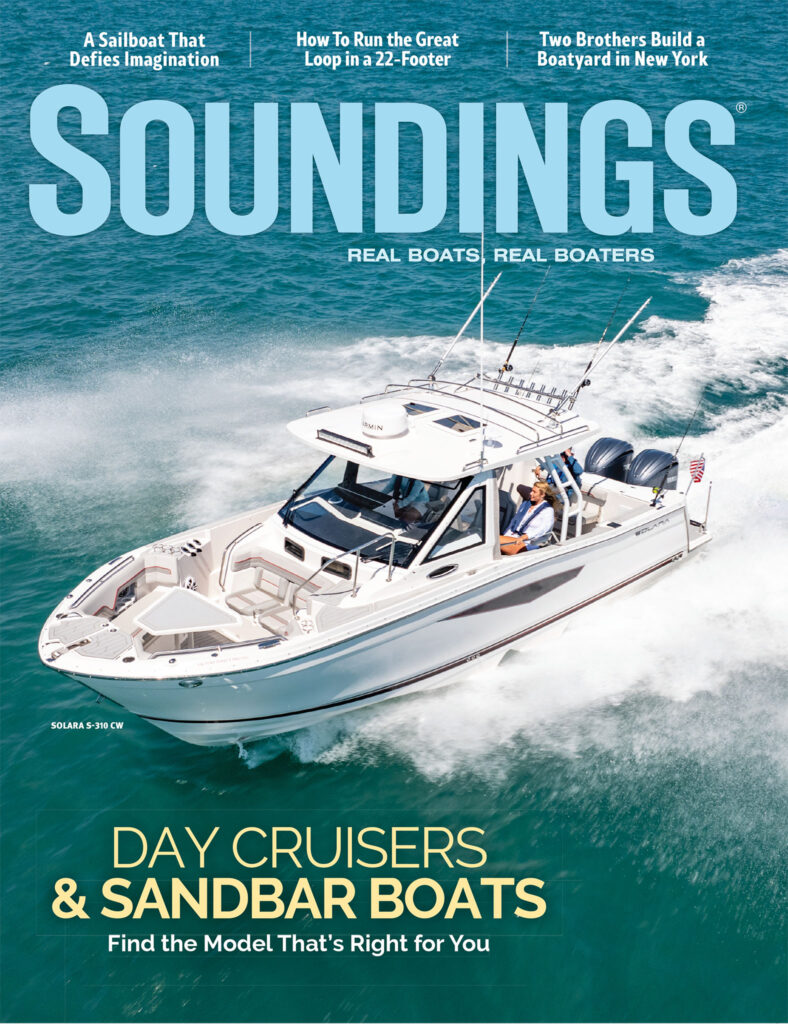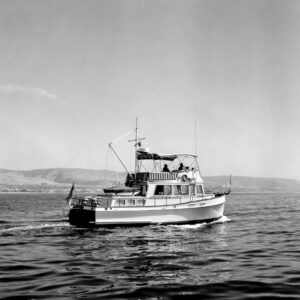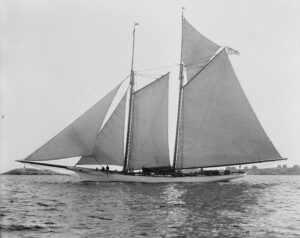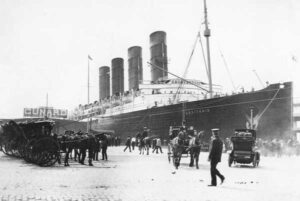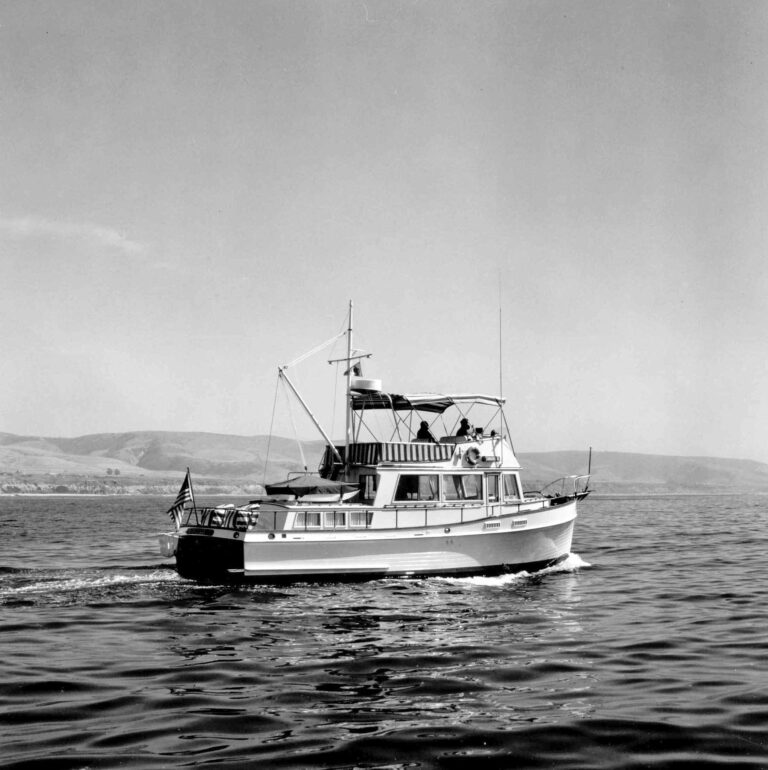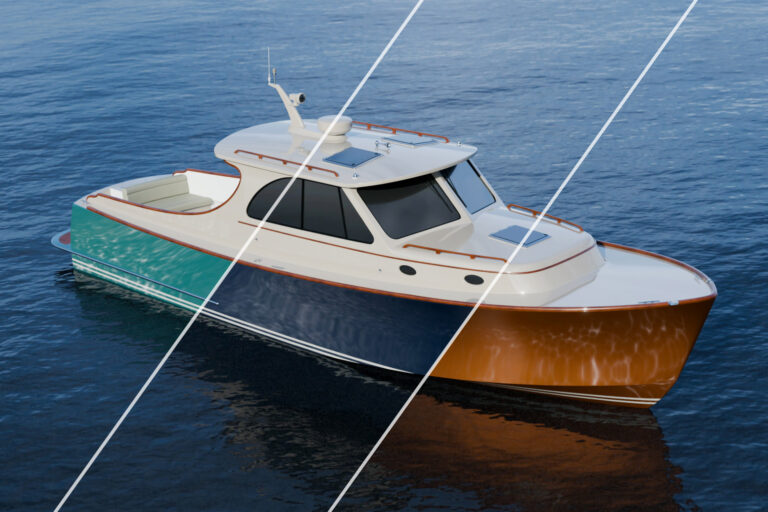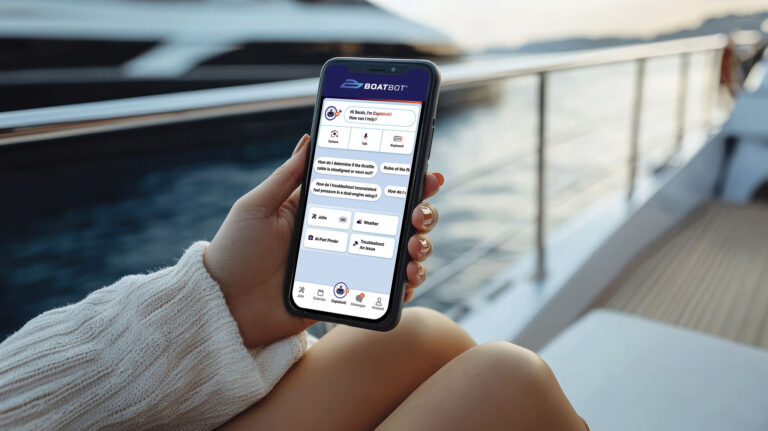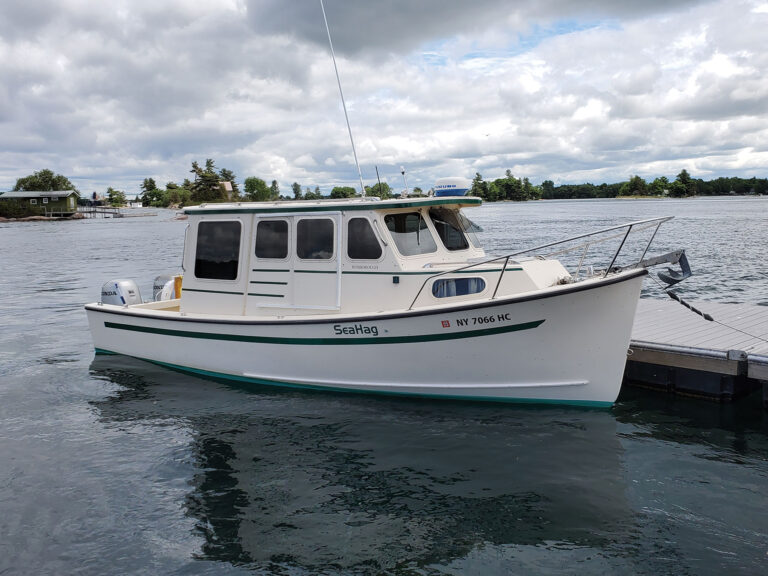When Capt. John Smith set about exploring Chesapeake Bay in 1608, he described the nearly 200-mile-long estuary as having oysters that “lay as thick as stones,” and being loaded with “sturgeon, grampus, porpoise, seals, stingrays, brits, mullets, rockfish, trout, soles and perch of three sorts.”
Smith also observed that the people of the region were adept at harvesting these bounties from the shallow, fruitful bay using dugout canoes that were hewn into a single piece by hand from felled trees. Remarkably, these simple but effective craft were the genesis of what would become one of the Chesapeake’s most iconic and recognizable vessels—the deadrise workboat.

With a proud, high bow, graceful sheer line, salty wheelhouse and expansive aft cockpit, the Chesapeake deadrise is a treat for the eyes. The design is so attractive and well-suited for the bay that boatbuilders now construct the craft using
modern techniques and materials for an eager group of recreational customers. How the design evolved over the last 100 years is an interesting story, and it begins with the boat’s hull shape.
According to Larry Chowning, author of Deadrise and Cross-Planked, the design can be traced back to the log canoe of the nineteenth century—a long, slender vessel built by carving out, shaping and then bolting logs together to form a hull. Most of these boats were sail-driven, allowing watermen to expand their reach and tap into the oyster, crab and fishing grounds farther afield. These vessels grew increasingly longer, and at some point, developed the design elements that would find their way into deadrise workboats, including V-shaped sterns and bows. “The V was ideal for contending with the Chesapeake’s shallow, choppy waters,” says Chowning.
According to Pete Lesher, chief curator at the Chesapeake Bay Maritime Museum in St. Michaels, Maryland, by the late 1800s the craft had grown in length to 50 feet. “These sail-driven bugeyes and skipjacks had some of the characteristics of a deadrise hull,” he says. “That deadrise, V-shaped bottom with a sharp bow begins to emerge in those boats.”
The next leap in design came in the early 20th century when the internal combustion engine became a propulsion solution for workboats. “You had to have a license to operate a steam-powered vessel,” Lesher explains. “From an economic standpoint, it wasn’t a viable solution. So, small naphtha engines began finding their way into boats. Instead of boiling water, you boil lighter fluid. Naphtha had a much lower boiling point and much lower pressures, so you didn’t need a steam engineer’s license to operate it.”
Retrofitting log-bottom workboats to install engines—and get a propeller shaft through the hull—was a challenge. “The internal combustion engine created all kinds of problems for builders,” says Chowning. Then the horn timber came along. “In Virginia, and Maryland, the shape was sort of like an S. They bolted the horn timber to the aft end of the keel, which gave an exit point for the shaft. This timber produces a concave stern shape.”

The horn timber and resulting stern shapes worked until engines became
powerful enough to push these hulls to near planing speeds. As the boats moved faster through the water, the sterns squatted, reducing performance. That’s when builders began experimenting with different stern styles on deadrise workboats. “One solution was a tuck stern, also known as a pot pie stern,” Lesher says. “The name comes from the way the aft ends of the boat are tucked up and out of the water on each side to reduce drag at higher speeds.”
In the early 20th century, when log-bottom boats were losing favor and
plank-on-frame boats were becoming more popular, workboats unique to specific regions began to emerge. One of them resembled the modern deadrise workboat: the Hooper Island draketail, also known as a dovetail. This long, slender boat was designed to move efficiently through the water using a small 3- to 5-hp engine. The draketail’s hallmark was a long, trailing stern with a rounded reverse transom. “The boat was developed for trotlining for crabs and hand-tonging for oysters. Since the naphtha and gasoline engines were still relatively lackluster in the power department, the draketail was conceived with efficiency in mind,” says Lesher. “The reverse stern adds additional buoyancy aft, and it lengthens the waterline.”
Workboats built in Maryland and Virginia continued to evolve with design cues pinned to specific areas on the bay. “In Anne Arundel County, Maryland, you get a peculiar style of deadrise that is open in the center with a low cuddy forward and a house in the stern,” Lesher says. “There are workboats with a standard round stern, which we identify with builders from Deltaville, Virginia. And there’s the diamond stern or V-stern that was centered around the coast of Virginia.” The V-stern was an adaptation by oystermen in the area, who often anchored their boats from the stern, which acted as a wave-breaking device.
A inimitable deadrise design is the Tangier and Smith islands’ scrape boat. It pulls toothless dredges across the eelgrass flats to harvest peeler crabs—blue crabs that are close to shedding their shell and used for the soft crab market. This boat is built with an extremely shallow draft for the skinny waters where crabs hide, has broad washboards (gunwales) for hauling aboard the dredges and sorting crabs, and features low freeboard with a sheer line that appears to kiss the water. It’s an outstanding example of a deadrise workboat adapted to a region and fishery.

Fiberglass roared onto the scene in the 1950s, but workboat builders were slow to adopt this new material. “The watermen hung onto their wood boats for a long time, for a couple of reasons,” Lesher says. “Wood boats can be upgraded and repaired almost indefinitely with proper care, which is a more economically feasible solution than buying a new fiberglass hull. Keeping a boat and repairing it just made more sense for a lot of watermen.”
Today, there are only a handful of workboat builders on the Chesapeake who still produce wooden craft. Among them are John Kinnamon on Tilghman Island and a few others scattered around the bay.
Still, fiberglass workboats based on time-tested wooden deadrise designs began appearing around the early 1970s. There were three pioneers in Virginia: Hulls Unlimited East of Deltaville; Gloucester Marine of Clay Bank; and Glass Marine of Hayes. Early fiberglass workboat builders in Maryland included Chesapeake Marine Industries of Trappe and Eugene Evans of Crisfield.
Chowning says a material, developed in Louisiana in 1972, revolutionized fiberglass workboat construction. “C-Flex consisted of continuous fiberglass rods that ran parallel to each other woven in a 12-inch-wide piece of cloth. Rolls of this material could be used as planking over a form like the frames and keels used in wood boats, and eliminated the expensive tooling costs that were previously prohibitive. Harry White of Rock Hall, Joe Kite of Smith Island and Albert Thomas of Solomons Island were innovators in C-Flex construction.”
Some boatbuilders leaned into building lines of molded fiberglass deadrise workboat hulls, such as Ronnie Carman of Marion Station, Maryland, who offered 27-, 32-, 36- and 46-foot hulls. Also on the scene was Cecil Robbins, who worked with fiberglass workboat godfather Glenn Manning to build fiberglass deadrise hulls, and Robert Meekins, who with Manning designed and built one of the most recognizable fiberglass deadrise boats on the bay today, a boat generically known as the Markley 46. These hulls were often finished off at the Markley yard near Baltimore, hence the name.

Some of the Carman molds ended up at Dave Mason’s Chesapeake Boats in Crisfield, Maryland, while the 22-, 29- and 40-foot Robbins molds ended up at Mathews Brothers in Denton, Maryland. The Markley 46 and Carman 32 molds traveled around a bit but today are housed at Composite Yacht, which builds an expansive line of deadrise and sportfishing boats at its facility in Trappe, Maryland. Other deadrise-style builders include Judge Yachts of Denton, and Elzey Boats in Cambridge, Maryland.
At Composite Yacht, a different kind of deadrise-style hull is taking shape. The new Composite Yacht 55, slated to launch later this year, is not built on a traditional deadrise hull, but it was inspired by the look of traditional Chesapeake working boats. Designed by naval architect Lou Codega, the CY55 is being built for an owner who loves the deadrise look but also wants a serious turn of speed.
“We’ve got an owner who loves deadrise boats but wants to go really, really fast,” says Composite Yacht’s Rob Hardy. “The build gives us the opportunity to use some materials and technologies that we’re really excited about. I can’t talk speed or performance numbers yet, but let’s just say fast is likely going to be an understatement with this boat. Everything we’ve done during the design and build has been aimed at a specific speed goal.”
The boat’s sportfish-style, carbon fiber hull and cored, carbon fiber deck and cabin house have elements of the traditional deadrise look. “The boat would likely be twice as heavy if we’d gone with a traditional fiberglass layup,” Codega says, “but we have the opportunity with this owner to really push the limits.”
To get the speed the customer demands, Codega had to design the hull much like a sportfish yacht and use carbon fiber laminates in its construction. “Its structural weight is actually less than that of a Regulator 41,” Codega says. “We would probably be twice as heavy if we used traditional fiberglass construction.”
While the boat rides on a modern, deep-V hull pushed by massive twin 1,900-hp MAN diesels, everything about its looks above the sheer line was drawn with deadrise design cues. “That little trunk cabin up forward, really we don’t need,” says Codega. “But that’s kind of a key styling thing with the deadrise. The long hardtop is kind of a yachty deadrise thing. The fashion plate—or sailboard as they call it—works into the hardtop and provides the kind of streamlined deadrise look we’re trying for. The three-pane windshield—that’s a deadrise cue. They’re not flat panels, but they’re relatively flat, triple-panes.”
Other builders on the bay have taken inspiration from the deadrise workboat to design recreational craft. Tom Weaver and Mick Price of Eastport Yacht Company used their combined creativity to produce the Eastport 32, a handsome boat with deadrise DNA. Though its tailgate stern, belowdecks accommodations and optional outboard power do not line up with the classic deadrise design, the Eastport 32’s lines do have an authentic workboat feel.

“The elements of the deadrise that we used in the Eastport 32, which differs from the Downeast/lobsterboat designs, are numerous,” Weaver says. “The low freeboard aft was a feature for oystermen and crabbers using trotlines. The low deadrise aft is typical of bay workboats, as it creates a stable platform for hauling crab pots and tonguing or dredging oysters. These features create a boat that is stable and friendly with the family on board and when fishing.” The large hardtop—often used on deadrise workboats to stack crab pots and fishing gear—provides protection from the elements.
The sporty Eastport 32 is most often powered with twin 260-hp Volvo Penta diesels that provide a top-end speed of 32 knots and a 25-knot cruise, giving the boat a range of approximately 400 miles. It draws only 1 foot, 10 inches and has a sharp entry for the short, steep chop the Chesapeake Bay is known for. Composite construction is used throughout.
Though fish, oyster and crab fisheries have declined significantly in the last 100 years, the Chesapeake Bay deadrise, whether constructed from wood or fiberglass, is still the preferred tool of the trade today for watermen making a living from the bay’s waters. And with a growing recreational following, the deadrise design is likely to be around in some form for many decades to come.
This article was originally published in the April 2021 issue.

